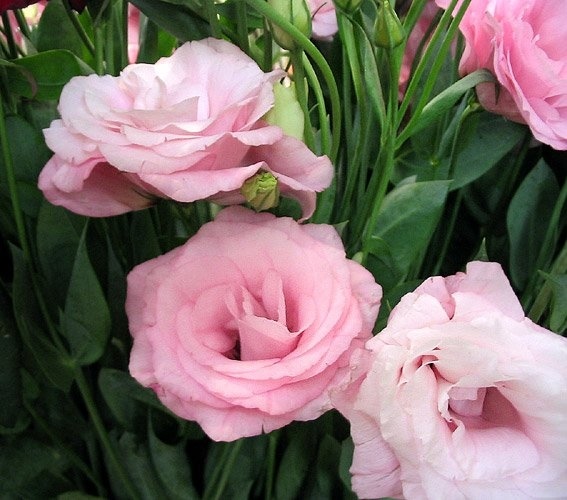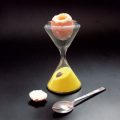You know, it can be very hard for me to explainfamiliar men and some girlfriends, what flowers I like. The only way out is to write a guide, not to give everyone a guided tour of the flower shops? So I'll start with my beloved Eustoma - with the medical name. He's like this: The subject of the conversation is lisianthus,eustomaPrairie gentian, lisianthus, Texas bluebell, Tulip gentian, bluebells, lira de san pedro is all Eustoma, a gentian relative. In our flower stalls responds to eustoma and lisianthus. The second name is more commercial - it sounds very medically "eustoma" (it turns out either "tasty" or "splendid" if refined in interpreting the Greek roots). Described plant in the XIX century, botanist Thomas Drummond, calling what he found in Texas Lisianthus russellianus. In the wild, the flower grows in the lowlands and on the banks of the rivers of Arizona, Colorado and northern Mexico. Wild eustoma - rather boring plant: squat, with flowers of different shades from blue to purple. In 1835 the flower got into the botanical garden of Glasgow, and then began to settle in pots on the windows. One way or another, the description of it as a houseplant appeared in 1878. The flower has gained immense popularity in Japan under the name Torukokikyo (Toruko "lady's hat" and Kikyo "bell", if absolutely, then Platycodon). In the late sixties of the XX century, it was discovered that there are white and pink eustoms. Since then, things have gone - terry and large-color varieties appeared, red, light yellow, bicolour flowers appeared. The flower proved to be convenient for transportation, spectacular in bouquets and long-lived in vases, there were also amateurs to grow it in pots. They write that "usually the seeds of the eustoma can not be purchased, since they come only to commercial flower farms. From one gram of seeds, it is theoretically possible to grow 15,000 plants. The process of development before the onset of the flowering phase in modern varieties lasts about three months. Seedlings contain high temperatures and additional artificial light. The technology of cultivation by the eustom is now developed to the smallest detail, flowering plants can be obtained at any time of the year. In order for the regime of growing these heat-loving flowers to be as economical as possible, they should be purchased in July. Then they will blossom all the second half of the summer, with little or no cost. They can be placed on the street, planted in flower beds or containers. Low-growing forms of eustoma are grown as houseplants. "
The subject of the conversation is lisianthus,eustomaPrairie gentian, lisianthus, Texas bluebell, Tulip gentian, bluebells, lira de san pedro is all Eustoma, a gentian relative. In our flower stalls responds to eustoma and lisianthus. The second name is more commercial - it sounds very medically "eustoma" (it turns out either "tasty" or "splendid" if refined in interpreting the Greek roots). Described plant in the XIX century, botanist Thomas Drummond, calling what he found in Texas Lisianthus russellianus. In the wild, the flower grows in the lowlands and on the banks of the rivers of Arizona, Colorado and northern Mexico. Wild eustoma - rather boring plant: squat, with flowers of different shades from blue to purple. In 1835 the flower got into the botanical garden of Glasgow, and then began to settle in pots on the windows. One way or another, the description of it as a houseplant appeared in 1878. The flower has gained immense popularity in Japan under the name Torukokikyo (Toruko "lady's hat" and Kikyo "bell", if absolutely, then Platycodon). In the late sixties of the XX century, it was discovered that there are white and pink eustoms. Since then, things have gone - terry and large-color varieties appeared, red, light yellow, bicolour flowers appeared. The flower proved to be convenient for transportation, spectacular in bouquets and long-lived in vases, there were also amateurs to grow it in pots. They write that "usually the seeds of the eustoma can not be purchased, since they come only to commercial flower farms. From one gram of seeds, it is theoretically possible to grow 15,000 plants. The process of development before the onset of the flowering phase in modern varieties lasts about three months. Seedlings contain high temperatures and additional artificial light. The technology of cultivation by the eustom is now developed to the smallest detail, flowering plants can be obtained at any time of the year. In order for the regime of growing these heat-loving flowers to be as economical as possible, they should be purchased in July. Then they will blossom all the second half of the summer, with little or no cost. They can be placed on the street, planted in flower beds or containers. Low-growing forms of eustoma are grown as houseplants. "

Making Money with Desserts: Success Stories
Yevhen Polishchuk (Fedutinov) instagram: @ evgeniyafedutinovavk.com / janeshomebaking– It all started with baking for relatives and friends. Gradually, she began uploading photos of her baking to Instagram, and orders began to come in. I made my first cake to order on October 13, 2014, and a little earlier I started making macarons and cupcakes. We can say that the business "found me myself", I am very [...]

Soups are cold recipes with photos
Cold cucumber soup with yogurt and lemonSorbet from La Taverna restaurant chef Alexander Zhurkina Photo: Getty Images Ingredients: Yoghurt without additives - 125 gCucumber - 150 gSorbet lemon / lime - 50 gCool shrimp - 24 gFresh ginger - 1 gLime lime - 5 gFresh orange juice - 5 gPetroshka - 1 g pink - 1 gCress salad - […]

barbeque kebab
Pork tenderloin glaze Photos: Dmitry Bayrak / dbstudio Cooking time: 20 minutes + time for pickling. Calorie content: 454 kcal per 1 serving. For 4 servings: 4 pork tenderloin (about 300 g each), 1 onion, 2 cloves of garlic, 1 tsp. lemon peel, 1 tsp. lemon juice, a pinch of ground cumin, coriander and turmeric, 1 tbsp. l vegetable [...]

Pierre Duacan: dietary recipes: Ducane diet
Beetroot Photo: Season'S, Luxury Hotels Representation You will need: · Boiled beets - 60 g · Fresh cucumbers - 20 g · Red radish - 20 g · Green onions - 10 g · Egg - 1 pcs · Mineral drinking water - 200 g · Salt - 1 g Ready: · Boil egg and beetroot. · Grind cucumbers, radishes and a part of beets. Putting everything [...]





